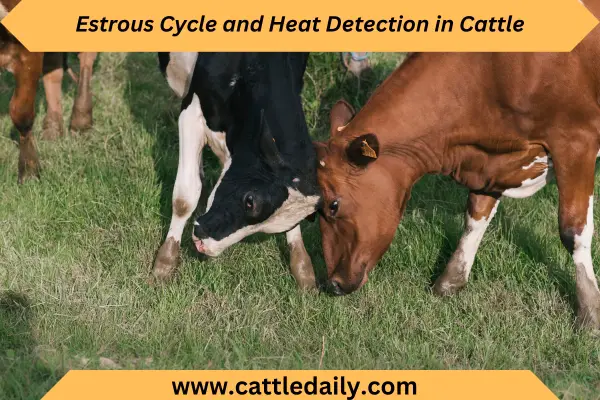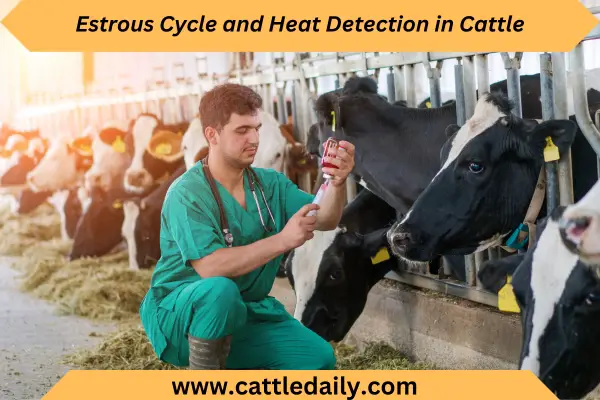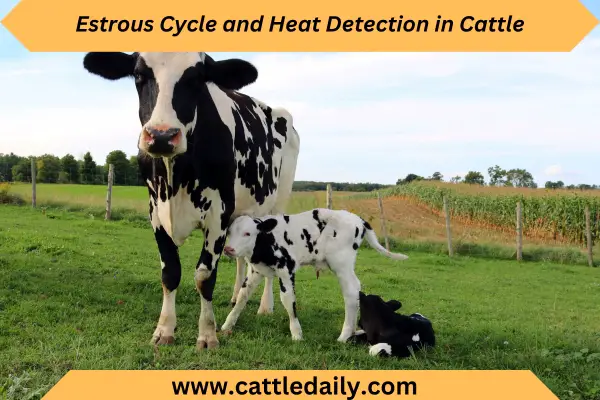Estrous Cycle and Heat Detection in Cattle
The estrous cycle, also known as the reproductive or ovulation cycle, is important for optimal reproductive performance in cattle. Detecting when cows and heifers are in heat allows for effective timing of artificial insemination or natural breeding.
Understanding the bovine estrous cycle and implementing a heat detection strategy are key to achieving high conception rates.
In this article, we will talk and explore about the signs and effecive heat deection strategies in cattle.
What is Estrous?
Estrous refers to the period when female cattle are sexually receptive to mating. It occurs during the follicular phase of the estrous cycle when estrogen levels peak, triggering physical and behavioral changes in the animal. This period when the cow is in standing heat is called estrus.
Length of the Estrous Cycle
The bovine estrous cycle lasts 18-24 days with an average of 21 days. This cycle comprises two main phases:
-
Follicular Phase
Lasting 4-6 days, this phase spans from the end of the previous luteal phase till ovulation. Under the stimulation of the follicle-stimulating hormone (FSH), follicles in the ovary mature.
As estrogen levels rise, it induces the cow to come into heat or estrus. The increasing size of the dominant follicle in the ovary suppresses FSH release through a negative feedback system.
-
Luteal Phase
This phase begins after ovulation and formation of the corpus luteum. Also known as the diestrous phase, it lasts about 14-18 days. The corpus luteum secretes progesterone which inhibits the release of hormones required for continued development of follicles in the ovary.
Towards the end of this phase, the corpus luteum starts regressing as progesterone levels decline. This triggers the beginning of the next follicular phase and a new estrous cycle.

Signs of Heat in Cattle
Primary Signs of Heat
Standing to be mounted by other cows. This is the most definitive sign of estrus. When a cow stands immobile while mounted by a herd-mate, it indicates the cow is in standing heat and ready for breeding. Cows not in heat will not tolerate being mounted. Standing heat typically lasts 6-12 hours.
Mounting herd mates; Cows in estrus will attempt to mount other members of the herd. They will clasp their front legs around the hips of another cow, simulating copulation. The duration and frequency of mounting behavior peak about 12 hours before ovulation.
Chin resting on the rumps of other cattle. In the early phase of heat, cows will rest their chin on the rumps of other cattle and may remain immobile. This precursor behavior can progress to full mounting as estrus intensifies.
Bellowing. Cows exhibit increased vocalization like frequent mooing and bellowing leading up to and during estrus. This is likely indicating their readiness to mate.
Clear mucus discharge. As estrogen levels rise prior to ovulation, cows will show a clear, stringy mucus discharge from the vulva. This fertile mucus facilitates sperm transport. Along with standing heat, discharge is a primary heat indicator.
Secondary Signs of Heat
Swollen and reddened vulva. Increased blood flow to the reproductive tract will cause the vulva and vaginal lining to appear swollen, reddened and more prominent as estrus nears. Vulva swelling may persist after end of standing heat.
Restlessness, walking fences frequently. Cows coming into heat will appear agitated and restless. They tend to walk fences and pace in search of a mate rather than grazing normally.
Rubbing and licking herself and herd mates. Frequent self-grooming and licking of their herd-mates occurs as estrus approaches due to nervous energy and discomfort associated with ovarian hormone changes.
Drop in milk production. There is a noticeable drop in daily milk yield just before and during estrus due to shifting hormone levels. This usually rebounds after breeding.
Decreased appetite. Pre-estrus cows often have decreased appetite and interest in feed. They have other mating priorities rather than eating during this time.
Head butting and riding other cows. Along with mouthing and chin resting, cows may butt heads with herd-mates using their horns or skulls prior to mounting.
Attempt to mount humans. Cows in obvious heat may attempt to mount humans due to their sexually charged state and inability to distinguish species during estrus.
Monitoring these primary and secondary signs of heat allow cattle producers to identify cows entering estrus for timely breeding decisions. Consistent observation is key to determining the optimal 12-hour ovulation window.

Effective Heat Detection Strategies
Since the fertile estrus period is relatively short, lasting about 18 hours, accurately identifying when cows are in standing heat is vital. A missed heat cycle means missed breeding opportunities.
Implementing a combination of visual heat detection aids can improve accuracy and prevent this loss of potential pregnancies.
-
Visual observation
Carrying out direct visual observation of cattle behavior is still the standard heat detection method. However, since estrus symptoms are displayed more prominently overnight, observation during daylight hours alone can miss heats.
Focus observation periods during early morning or late evenings when cows are more active. Watch for clusters of animal activity and the primary standing heat signs. Isolate those cows exhibiting strong heat symptoms for further monitoring.
-
Tail paint or chalk
Applying paint or chalk to the tailhead area helps pinpoint cattle that have been mounted, as the markings will be rubbed off. Once or twice daily checks for any missing paint or chalk indicates possible heat onset. Reapply to all cattle at the end of each check.
-
Heat detection patches
Similar to tail paint, these adhesive patches stick to the tailhead and change color when rubbed off due to mounting activity. Patches are available in self-adhesive or glue formats. They provide visible heat detection for up to 14 days.
-
Pedometers
Pedometers measure the walking and mounting motion of cattle in heat. Increased physical activity sends data to the pedometer, which can transmit real-time estrus alerts. This allows for rapid identification and isolation of cows in standing heat.
-
Heat detection technologies
Other tech-based estrus monitoring systems include pressure-sensing patches, progesterone tests for milk, vaginal mucus or blood, and video monitoring with AI notification software. These provide 24-hour heat detection with minimal labor requirements.
Breeding During Optimal Estrus Phase
The fertile window for breeding cattle is narrow. Ovulation occurs 24-32 hours following the onset of estrus. So breed 6-12 hours after first observing standing heat for the best conception rates. Continue observing bred cows 21 days later to detect heat and confirm pregnancy.
Accurately monitoring the estrous cycle and heat detection allows cattle producers to effectively time artificial insemination or bull breeding. This helps optimize reproductive performance for a productive calving season. Consistently high heat detection rates lead to better fertility, milk production and calf crops.
Key Takeaways:
- The bovine estrous cycle lasts 18-24 days on average and governs the animal’s reproductive cycle.
- Estrous refers to the period when cows exhibit physical and behavioral signs of being in standing heat or estrus.
- Accurately detecting heat is vital for timely artificial insemination and high conception rates.
- Tail paint, patches, pedometers and AI tech can aid visual observation of primary estrus signs like standing to be mounted.
- Breed cows 6-12 hours after first detected standing heat for optimal fertility.
Conclusion
Managing the estrous cycle through accurate heat detection enables cattle producers to make timely breeding decisions. This helps achieve excellent conception rates and reproductive efficiency.
Consistent monitoring of estrus symptoms combined with breeding during peak fertility results in more pregnancies and ultimately, greater productivity and profits. Estrous cycle tracking and heat detection are fundamental to profitable cattle operations. Learn here more about cattle reproduction tips and guidance.


